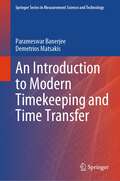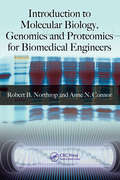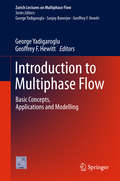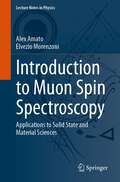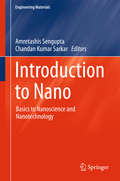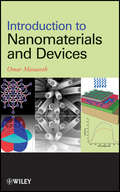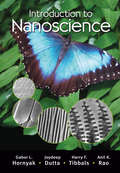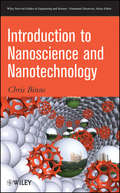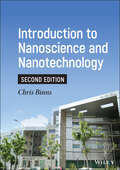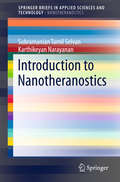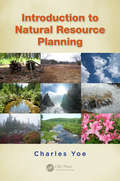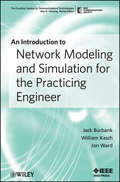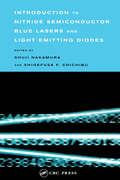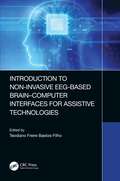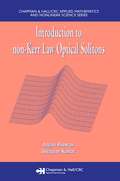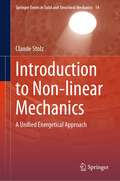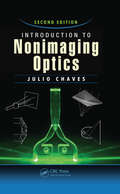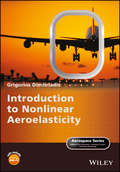- Table View
- List View
An Introduction to Modern Timekeeping and Time Transfer (Springer Series in Measurement Science and Technology)
by Parameswar Banerjee Demetrios MatsakisThis book provides a comprehensive, systematic description of modern timekeeping and its specializations. Introductory chapters discuss the concept of time and its definition, then briefly look at pre-Atomic Era timekeeping to set the stage for the introduction of the atomic clock. Subsequent chapters focus on concepts such as frequency stability and measurement uncertainty, as well as computer network time-synchronization protocols including Network Time Protocol (NTP) and Precise Time Protocol (PTP). The book then delves into the nuts and bolts of the Global Navigation Satellite Systems (GNSS), Two-Way Satellite Time and Frequency Transfer, and Optical Time and Frequency Transfer. Timescale theory is then described as a way to combine clock data, and the algorithms and procedures used to generate Coordinated Universal Time (UTC) are given. Finally, there is a look at modern applications of timekeeping and time transfer.Featuring a glossary of all key terms, this book is highly recommended for trained or incoming physicists, engineers, or mathematicians working, for example, in manufacturing or timing laboratories. Additionally, it is suitable for use in introductory university courses dealing with the subject of timekeeping.
Introduction to Molecular Biology, Genomics and Proteomics for Biomedical Engineers
by Robert B. Northrop Anne N. ConnorIllustrates the Complex Biochemical Relations that Permit Life to ExistIt can be argued that the dawn of the 21st century has emerged as the age focused on molecular biology, which includes all the regulatory mechanisms that make cellular biochemical reaction pathways stable and life possible. For biomedical engineers, this concept is essential to
Introduction to Multicopter Design and Control
by Quan QuanThis book is the first textbook specially on multicopter systems in the world. It provides a comprehensive overview of multicopter systems, rather than focusing on a single method or technique. The fifteen chapters are divided into five parts, covering the topics of multicopter design, modeling, state estimation, control, and decision-making. It differs from other books in the field in three major respects: it is basic and practical, offering self-contained content and presenting hands-on methods; it is comprehensive and systematic; and it is timely. It is also closely related to the autopilot that users often employ today and provides insights into the code employed. As such, it offers a valuable resource for anyone interested in multicopters, including students, teachers, researchers, and engineers. This introductory text is a welcome addition to the literature on multicopter design and control, on which the author is an acknowledged authority. The book is directed to advanced undergraduate and beginning graduate students in aeronautical and control (or electrical) engineering, as well as to multicopter designers and hobbyists. ------- Professor W. Murray Wonham, University of Toronto "This is the single best introduction to multicopter control. Clear, comprehensive and progressing from basic principles to advanced techniques, it's a must read for anyone hoping to learn how to design flying robots. " ------- Chris Anderson, 3D Robotics CEO.
Introduction to Multiphase Flow
by George Yadigaroglu Geoffrey F. HewittThis book is the maiden volume in a new series devoted to lectures delivered through the annual seminars "Short Courses on Multiphase Flow," held primarily at ETH Zurich continuously since 1984. The Zurich short courses, presented by prominent specialists in the various topics covered, have attracted a very large number of participants. This series presents fully updated and when necessary re-grouped lectures in a number of topical volumes. The collection aims at giving a condensed, critical and up-to-date view of basic knowledge on multiphase flows in relation to systems and phenomena encountered in industrial applications. The present volume covers the background of Multiphase Flows (MPF) that introduces the reader to the particular nature and complexity of multiphase flows and to basic but critical aspects of MPFs including concepts and the definition of the quantities of interest, an introduction to modelling strategies for MPFs, flow regimes, flow regime maps and tr ansition criteria. It also deals with the ubiquitous needs of the multiphase-flow modeller, namely pressure drop and phase distribution, i. e. , the void fraction and the topology of the phases that determines the flow regimes.
Introduction to Municipal Water Quality Management (Routledge/UNISA Press Series)
by Johannes HaarhoffThe focus of municipalities has been on the supply of sufficient water quantities to the public with less attention paid to water quality. The deteriorating quality of raw water sources necessitates increased attention to water quality with professional scientists playing a central role at municipalities and water boards together with professional engineers. With many stringent regulations on the quality of drinking water and recreational water bodies, the young municipal chemist needs a handy manual to assist in the often neglected and complicated field of municipal water management. Grounded in Science, Introduction to Municipal Water Quality Management not only links theory and regulations in practice but also offers simple numerical examples to better understand the rules and encourage a quantitative application to everyday problems. Developed from a series of lectures between 2015 and 2019, Introduction to Municipal Water Quality Management will give young professionals the confidence to analyse their results and apply their knowledge in a numerical fashion.
Introduction to Muon Spin Spectroscopy: Applications to Solid State and Material Sciences (Lecture Notes in Physics #961)
by Alex Amato Elvezio MorenzoniThis textbook serves as a comprehensive introduction to muon spin spectroscopy (µSR), offering a detailed exploration of how polarized positive muons can be employed as local probes to investigate material properties at the microscopic level. It provides a self-contained tutorial that begins by explaining the extraction of physical information from a µSR experiment and then proceeds to present illustrative examples in the fields of condensed matter physics, materials science, and nanoscience.The book focuses on major applications of µSR, including the study of magnetism, superconductivity, and semiconducting materials in both bulk and thin film samples. In addition, two chapters delve into the applications of negative muons, emphasizing their role in elemental materials analysis and introducing fundamental particle physics aspects of muon science. Supplementary material, conveniently summarized in several appendices, covers essential basic concepts.For further exploration, an extensive list of references is provided, enabling readers to deepen their knowledge in specific areas.To facilitate understanding and mastery of the subject, the textbook offers exercises and solutions. It caters to advanced undergraduate, graduate and PhD level students, researchers who intend to utilize the µSR technique or seek a comprehensive understanding of µSR results for their research, as well as to established practitioners.
Introduction to Nano
by Amretashis Sengupta Chandan Kumar SarkarThis book covers the basics of nanotechnology and provides a solid understanding of the subject. Starting from a brush-up of the basic quantum mechanics and materials science, the book helps to gradually build up understanding of the various effects of quantum confinement, optical-electronic properties of nanoparticles and major nanomaterials. The book covers the various physical, chemical and hybrid methods of nanomaterial synthesis and nanofabrication as well as advanced characterization techniques. It includes chapters on the various applications of nanoscience and nanotechnology. It is written in a simple form, making it useful for students of physical and material sciences.
Introduction to Nanoelectronics
by Vladimir V. Mitin Viatcheslav A. Kochelap Michael A. StroscioTextbook presenting the fundamentals of nanoscience and nanotechnology with a view to nanoelectronics. Covers the underlying physics; nanostructures, including nanoobjects; methods for growth, fabrication and characterization of nanomaterials; and nanodevices. Provides a unifying framework for the basic ideas needed to understand the recent developments in the field. Includes numerous illustrations, homework problems and a number of interactive Java applets. For advanced undergraduate and graduate students in electrical and electronic engineering, nanoscience, materials, bioengineering and chemical engineering. Instructor solutions and Java applets available from www. cambridge. org/9780521881722.
Introduction to Nanofiber Materials
by Frank K. Ko Yuqin WanPresenting the latest coverage of the fundamentals and applications of nanofibrous materials and their structures for graduate students and researchers, this book bridges the communication gap between fiber technologists and materials scientists and engineers. Featuring intensive coverage of electroactive, bioactive and structural nanofibers, it provides a comprehensive collection of processing conditions for electrospinning and includes recent advances in nanoparticle-/nanotube-based nanofibers. The book also covers mechanical properties of fibers and fibrous assemblies, as well as characterisation methods.
Introduction to Nanomaterials and Devices
by Omar ManasrehAn invaluable introduction to nanomaterials and their applicationsOffering the unique approach of applying traditional physics concepts to explain new phenomena, Introduction to Nanomaterials and Devices provides readers with a solid foundation on the subject of quantum mechanics and introduces the basic concepts of nanomaterials and the devices fabricated from them. Discussion begins with the basis for understanding the basic properties of semiconductors and gradually evolves to cover quantum structures--including single, multiple, and quantum wells--and the properties of nanomaterial systems, such as quantum wires and dots.Written by a renowned specialist in the field, this book features:An introduction to the growth of bulk semiconductors, semiconductor thin films, and semiconductor nanomaterialsInformation on the application of quantum mechanics to nanomaterial structures and quantum transportExtensive coverage of Maxwell-Boltzmann, Fermi-Dirac, and Bose-Einstein stastisticsAn in-depth look at optical, electrical, and transport propertiesCoverage of electronic devices and optoelectronic devicesCalculations of the energy levels in periodic potentials, quantum wells, and quantum dotsIntroduction to Nanomaterials and Devices provides essential groundwork for understanding the behavior and growth of nanomaterials and is a valuable resource for students and practitioners in a field full of possibilities for innovation and invention.
Introduction to Nanophotonics
by Sergey V. GaponenkoNanophotonics is where photonics merges with nanoscience and nanotechnology, and where spatial confinement considerably modifies light propagation and light-matter interaction. Describing the basic phenomena, principles, experimental advances and potential impact of nanophotonics, this graduate-level textbook is ideal for students in physics, optical and electronic engineering and materials science. The textbook highlights practical issues, material properties and device feasibility, and includes the basic optical properties of metals, semiconductors and dielectrics. Mathematics is kept to a minimum and theoretical issues are reduced to a conceptual level. Each chapter ends in problems so readers can monitor their understanding of the material presented. The introductory quantum theory of solids and size effects in semiconductors are considered to give a parallel discussion of wave optics and wave mechanics of nanostructures. The physical and historical interplay of wave optics and quantum mechanics is traced. Nanoplasmonics, an essential part of modern photonics, is also included.
Introduction to Nanoscience
by Joydeep Dutta Gabor L. Hornyak H.F. Tibbals Anil RaoTomorrow's nanoscientist will have a truly interdisciplinary and nano-centric education, rather than, for example, a degree in chemistry with a specialization in nanoscience. For this to happen, the field needs a truly focused and dedicated textbook. This full-color masterwork is such a textbook. It introduces the nanoscale along with the societal
Introduction to Nanoscience and Nanotechnology (Wiley Survival Guides in Engineering and Science #14)
by Chris BinnsIntroduction to Nanoscience and Nanotechnology explains nanotechnology to an audience that does not necessarily have a scientific background. It covers all aspects, including the new areas of biomedical applications and the use of nanotechnology to probe the "quantum vacuum." After discussing the present state of the art in nanotechnology, the book makes estimates of where these technologies are going and what will be possible in the future.
Introduction to Nanoscience and Nanotechnology (Wiley Survival Guides In Engineering And Science Ser. #6)
by Chris BinnsThe book presents nanoscience and nanotechnology to a broad audience that does not necessarily have a scientific background. This book starts with the fundamental physicochemical properties of nanoparticles and nanostructures, and discusses how these special properties can be manipulated to produce high-performance materials and devices. In the following chapters, the scope is broadened to cover naturally occurring nanoparticles and artificially-engineered carbon nanoparticles, their mechanical properties, and their importance to the rest of nanotechnology. The book also covers the two design ideologies for manufacturing nanostructures, the bottom-up and top-down methods, and discusses how these two can be combined to allow for the imaging, probing and manipulation of nanostructures. The remainder of the book surveys the current state of nanotechnology, including the use of single-nanoparticle devices in data storage, electronics, optics, and solar power; advances in nanoparticle manufacturing and biotechnology that can lead to powerful new cancer treatments; and the use of nanotechnology to study the “quantum vacuum”.
Introduction to Nanoscience and Nanotechnology
by John J. Moore Joydeep Dutta Gabor L. Hornyak H.F. TibbalsThe maturation of nanotechnology has revealed it to be a unique and distinct discipline rather than a specialization within a larger field. Its textbook cannot afford to be a chemistry, physics, or engineering text focused on nano. It must be an integrated, multidisciplinary, and specifically nano textbook. The archetype of the modern nano textbook
Introduction to Nanotheranostics
by Subramanian Tamil Selvan Karthikeyan NarayananThis book offers readers an introduction to the current status of nanoparticles and other nanomaterials that have potential applications in theranostics. Above all, it highlights the diagnostic and therapeutic applications of metallic (e. g. Au, Ag), semiconducting quantum dots (e. g. CdSe, CdTe), magnetic (e. g. Fe3O4, FePt, Co), and multifunctional (combination of two or three) nanoparticles.
Introduction to Natural Resource Planning
by Charles YoeThis is an exciting time for natural resources planning. There are amazing technologies available to planners and a wide and growing array of resources, problems, and opportunities that need attention. Private and public interests are taking up these issues all over the world and at all levels of involvement. At the same time, inefficient planning
An Introduction to Network Modeling and Simulation for the Practicing Engineer (The ComSoc Guides to Communications Technologies #5)
by Jack L. Burbank William Kasch Jon WardThis book provides the practicing engineer with a concise listing of commercial and open-source modeling and simulation tools currently available including examples of implementing those tools for solving specific Modeling and Simulation examples. Instead of focusing on the underlying theory of Modeling and Simulation and fundamental building blocks for custom simulations, this book compares platforms used in practice, and gives rules enabling the practicing engineer to utilize available Modeling and Simulation tools. This book will contain insights regarding common pitfalls in network Modeling and Simulation and practical methods for working engineers.
Introduction to Nitride Semiconductor Blue Lasers and Light Emitting Diodes
by Shuji Nakamura Shigefusa F. ChichibuThe "blue laser" is an exciting new device used in physics. The potential is now being recognized for its development into a commercial lighting system using about a tenth of the power and with a thousand times the operating lifetime of a comparable conventional system. This comprehensive work introduces the subject at a level suitable for graduate
Introduction to Non-Invasive EEG-Based Brain-Computer Interfaces for Assistive Technologies
by Teodiano Freire Bastos-FilhoThis book aims to bring to the reader an overview of different applications of brain-computer interfaces (BCIs) based on more than 20 years of experience working on these interfaces. The author provides a review of the human brain and EEG signals, describing the human brain, anatomically and physiologically, with the objective of showing some of the patterns of EEG (electroencephalogram) signals used to control BCIs. It then introduces BCIs and different applications, such as a BCI based on ERD/ERS Patterns in α rhythms (used to command a robotic wheelchair with an augmentative and alternative communication (AAC) system onboard it); a BCI based on dependent-SSVEP to command the same robotic wheelchair; a BCI based on SSVEP to command a telepresence robot and its onboard AAC system; a BCI based on SSVEP to command an autonomous car; a BCI based on independent-SSVEP (using Depth-of-Field) to command the same robotic wheelchair; the use of compressive technique in SSVEP-based BCI; a BCI based on motor imagery (using different techniques) to command a robotic monocycle and a robotic exoskeleton; and the first steps to build a neurorehabilitation system based on motor imagery of pedalling together an in immersive virtual environment. This book is intended for researchers, professionals and students working on assistive technology.
Introduction to non-Kerr Law Optical Solitons
by Anjan Biswas Swapan KonarDespite remarkable developments in the field, a detailed treatment of non-Kerr law media has not been published. Introduction to non-Kerr Law Optical Solitons is the first book devoted exclusively to optical soliton propagation in media that possesses non-Kerr law nonlinearities.After an introduction to the basic features of fiber-optic com
Introduction to Non-linear Mechanics: A Unified Energetical Approach (Springer Series in Solid and Structural Mechanics #14)
by Claude StolzThis book presents an introduction to the non-linear mechanics of materials, focusing on a unified energetical approach. It begins by summarizing the framework of a thermodynamic description of continua, including a description of the kinematics of deformation, and a summary of the equations of motion. After a short description of the motion of the system and the mechanical interaction, the book introduces the Lagrangean and Hamiltonian functionals of the system, transitioning to the quasistatic characterization with emphasis on the role of potential energy and pseudo-potential of dissipation. The framework is then extended to fracture and damage mechanics with a similar energetical approach proposed for material damage and wear. The book looks at homogenization in non-linear mechanics for locally plastic or damaged material with an analysis of stability and bifurcation of the equilibrium path. Lastly, inverse problems in non-linear mechanics are introduced using optimal control theory. All the concepts introduced in the book are illustrated using analytical solutions on beams, rods, plates, or using spherical and cylindrical symmetries. Graduate students and researchers working on continuum mechanics and interested in a deeper understanding of materials damage, wear, and fatigue will find this book instructive and informative.
Introduction to Nonextensive Statistical Mechanics: Approaching a Complex World
by Constantino TsallisThis book focuses on nonextensive statistical mechanics, a current generalization of Boltzmann-Gibbs (BG) statistical mechanics.Conceived nearly 150 years ago by Maxwell, Boltzmann and Gibbs, the BG theory, one of the greatest monuments of contemporary physics, exhibits many impressive successes in physics, chemistry, mathematics, and computational sciences. Presently, several thousands of publications by scientists around the world have been dedicated to its nonextensive generalization. A variety of applications have emerged in complex systems and its mathematical grounding is by now well advanced.Since the first edition release thirteen years ago, there has been a vast amount of new results in the field, all of which have been incorporated in this comprehensive second edition. Heavily revised and updated with new sections and figures, the second edition remains the go-to text on the subject.A pedagogical introduction to the BG theory concepts and their generalizations – nonlinear dynamics, extensivity of the nonadditive entropy, global correlations, generalization of the standard CLT’s, complex networks, among others – is presented in this book, as well as a selection of paradigmatic applications in various sciences together with diversified experimental verifications of some of its predictions. Introduction to Nonextensive Statistical Mechanics is suitable for students and researchers with an interest in complex systems and statistical physics.
Introduction to Nonimaging Optics
by Julio ChavesIntroduction to Nonimaging Optics covers the theoretical foundations and design methods of nonimaging optics, as well as key concepts from related fields. This fully updated, revised, and expanded Second Edition: Features a new and intuitive introduction with a basic description of the advantages of nonimaging optics Adds new chapters on wavefronts for a prescribed output (irradiance or intensity), infinitesimal étendue optics (generalization of the aplanatic optics), and Köhler optics and color mixing Incorporates new material on the simultaneous multiple surface (SMS) design method in 3-D, integral invariants, and étendue 2-D Contains 21 chapters, 24 fully worked and several other examples, and 1,000+ illustrations, including photos of real devices Addresses applications ranging from solar energy concentration to illumination engineering Introduction to Nonimaging Optics, Second Edition invites newcomers to explore the growing field of nonimaging optics, while providing seasoned veterans with an extensive reference book.
Introduction to Nonlinear Aeroelasticity
by Grigorios DimitriadisIntroduction to Nonlinear Aeroelasticity Grigorios Dimitriadis, University of Liège, Belgium Introduces the latest developments and technologies in the area of nonlinear aeroelasticity Nonlinear aeroelasticity has become an increasingly popular research area in recent years. There have been many driving forces behind this development, increasingly flexible structures, nonlinear control laws, materials with nonlinear characteristics, etc. Introduction to Nonlinear Aeroelasticity covers the theoretical basics in nonlinear aeroelasticity and applies the theory to practical problems. As nonlinear aeroelasticity is a combined topic, necessitating expertise from different areas, the book introduces methodologies from a variety of disciplines such as nonlinear dynamics, bifurcation analysis, unsteady aerodynamics, non-smooth systems and others. The emphasis throughout is on the practical application of the theories and methods, so as to enable the reader to apply their newly acquired knowledge. Key features: Covers the major topics in nonlinear aeroelasticity, from the galloping of cables to supersonic panel flutter. Discusses nonlinear dynamics, bifurcation analysis, numerical continuation, unsteady aerodynamics and non-smooth systems. Considers the practical application of the theories and methods. Covers nonlinear dynamics, bifurcation analysis and numerical methods. Accompanied by a website hosting Matlab code. Introduction to Nonlinear Aeroelasticity is a comprehensive reference for researchers and workers in industry and is also a useful introduction to the subject for graduate and undergraduate students across engineering disciplines.
